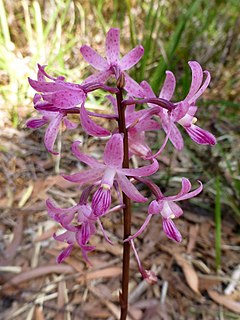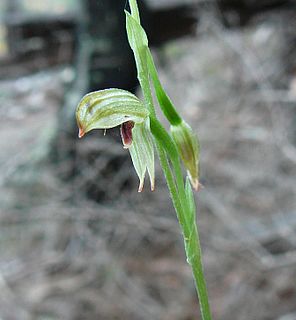
Gastrodia, commonly known as potato orchids or as 天麻属 , is a genus of terrestrial leafless orchids in the family Orchidaceae, about ninety of which have been described. Orchids in this genus have fleshy, upright stems and small to medium-sized resupinate flowers with narrow sepals and petals. They are native to Asia, Australia, New Zealand, central Africa, and various islands of the Indian and Pacific Oceans.

Dipodium roseum, commonly known as rosy hyacinth-orchid or pink hyacinth-orchid, is a leafless saprophytic orchid found in east and south-eastern Australia. In summer it produces a tall flowering stem with up to fifty pale pink flowers with small, dark red spots. A widespread and common species it is often confused with D. punctatum but has darker, less heavily spotted flowers.

Burnettia cuneata, commonly known as the lizard orchid, is the only species of the flowering plant genus Burnettia in the orchid family, Orchidaceae. It is a leafless terrestrial, mycotrophic herb with one or two leaf-like bracts and up to seven flowers that are brownish on the back and pink or white inside. It is endemic to southeastern Australia where it grows in dense thickets in swamps.

Caleana, commonly known as duck orchids, is a genus of flowering plants in the orchid family, Orchidaceae that is found in Australia and New Zealand. The Australian species are found in all states but have not been recorded in the Northern Territory. Duck orchids have a single leaf and one or a few, dull-coloured, inconspicuous flowers. Most species are found in Western Australia but one species occurs in eastern Australia and one occurs in eastern Australia and New Zealand. Orchids in this genus as well as the hammer orchids (Drakaea) are pollinated by male thynnid wasps.

Aphyllorchis queenslandica, commonly known as the yellow pauper orchid, is a leafless terrestrial mycotrophic orchid in the family Orchidaceae. It has up to twelve dull yellow flowers on a thin, fleshy, purple flowering stem and is endemic to tropical north Queensland where it grows in rainforest.

Gastrodia sesamoides, commonly known as cinnamon bells or common potato orchid in Australia and as the pot-bellied orchid or cinnamon sticks in New Zealand, is a leafless, terrestrial saprophytic orchid in the family Orchidaceae. It has a thin, fleshy brown flowering stem and up to twenty five drooping, brownish, self-pollinating flowers that are white inside. Growing in a wide range of habitats, it is native to Australia and New Zealand.

Pterostylis squamata, commonly known as the southern rustyhood or ruddyhood, is a plant in the orchid family Orchidaceae and is endemic to south-eastern Australia. Flowering plants have up to ten translucent green flowers with reddish-brown markings and a hairy, insect-like labellum. Non-flowering plants have a rosette of four to eight egg-shaped leaves. This species is very similar to Pterostylis rufa which has a narrower labellum and other minor differences.

Pterostylis tunstallii, commonly known as Tunstall's greenhood or granite greenhood is a plant in the orchid family Orchidaceae and is endemic to south-eastern Australia. Flowering plants have up to ten transparent green flowers which have a dark brown, insect-like labellum with a blackish "head". Non-flowering plants have a rosette of leaves on a short stalk but flowering plants lack the rosette, instead having five to eight stem leaves.

Pterostylis williamsonii, commonly known as the brown-lip leafy greenhood, is a plant in the orchid family Orchidaceae and is endemic to Tasmania. Flowering plants have up to seven transparent green flowers with darker green and brown bands and a hairy, insect-like labellum with a blackish stripe. Non-flowering plants have a rosette of leaves on a short stalk but flowering plants lack the rosette, instead having five to seven stem leaves.
Genoplesium confertum, commonly known as the crowded midge orchid, is a small terrestrial orchid endemic to the south-east of Queensland. It has a single thin leaf fused to the flowering stem and up to sixty small, densely crowded, reddish and green flowers and grows in coastal heath.

Chiloglottis valida, commonly known as the large bird orchid or common bird orchid, is a species of orchid endemic to south-eastern Australia.It has two dark green leaves and a single greenish purple to purplish brown flower with six to ten blackish, column-like calli on the labellum.
Arthrochilus aquilus, commonly known as the dark elbow orchid, is a flowering plant in the orchid family (Orchidaceae) and is endemic to the northern part of Cape York in Queensland. It has up to five dark green leaves at its base and up to fifteen pale green, insect-like flowers with dark reddish black glands on its labellum.
Calochilus pruinosus, commonly known as the mallee beard orchid, is a species of orchid endemic to southern continental Australia. It has up to fifteen dull greenish, pinkish or brownish flowers with red lines and a labellum with a purplish "beard", but is leafless.
Aphyllorchis anomala, commonly known as the simple pauper orchid, is a leafless terrestrial mycotrophic orchid in the family Orchidaceae. It has up to twenty white flowers with purple markings on a deep purple flowering stem and grows in shady rainforest in tropical north Queensland.
Gastrodia queenslandica, commonly known as rainforest bells, is a leafless terrestrial mycotrophic orchid in the family Orchidaceae. It has one or two small, yellowish brown, tube-shaped flowers on a thin, brittle flowering stem and grows in rainforest in tropical north Queensland, Australia.
Gastrodia crebriflora, commonly known as dense potato orchid, is a leafless terrestrial mycotrophic orchid in the family Orchidaceae. It has a pale brown flowering stem and up to thirty five crowded, drooping, white to pale brown flowers. It is only known from the Blackdown Tableland in Queensland, Australia.
Gastrodia lacista, commonly known as the western potato orchid, is a leafless terrestrial mycotrophic orchid in the family Orchidaceae. It has a thin brown flowering stem with up to fifty small, drooping, fawn and white, tube-shaped flowers. It grows in forest and woodland in the south-west of Western Australia.

Gastrodia procera, commonly known as the tall potato orchid, is a leafless terrestrial mycotrophic orchid in the family Orchidaceae. It has a robust, dark brown to blackish flowering stem with up to seventy cinnamon brown, tube-shaped flowers that are white inside. It grows in high rainfall forest in southeastern Australia.
Gastrodia urceolata, commonly known as white potato orchid, is a leafless terrestrial mycotrophic orchid in the family Orchidaceae. It has a pale brown, fleshy flowering stem and up to fifty five upright, white to pale brown flowers. It is only known from a single population near Atherton in Queensland.
Gastrodia vescula, commonly known as small potato orchid, is a leafless terrestrial mycotrophic orchid in the family Orchidaceae. It has a very thin, brittle, light brown flowering stem with up to three pale brown flowers that are white on the inside. It is only known from a small area near the border between South Australia and Victoria.











